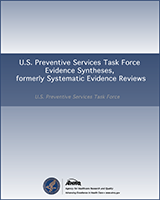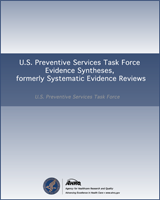NCBI Bookshelf. A service of the National Library of Medicine, National Institutes of Health.
This publication is provided for historical reference only and the information may be out of date.
Structured Abstract
Objective:
To review the benefits and harms of behavioral counseling interventions to improve diet and increase physical activity in adults with cardiovascular risk factors.
Data Sources:
We performed a search of MEDLINE, PubMed (publisher-supplied records only), PsycINFO, and the Cochrane Central Register of Controlled Trials for relevant English-language studies published between January 2013 and September 2019. Additionally, we re-evaluated all studies included in the 2014 USPSTF review and related USPSTF systematic reviews. We conducted ongoing surveillance for relevant literature through July 24, 2020.
Study Selection:
Two investigators independently reviewed 14,409 unique citations and 466 full-text articles against a priori inclusion criteria. We included English-language randomized clinical trials of behavioral counseling interventions to help people with elevated blood pressure or lipids improve their diet and increase physical activity. Critical appraisal was completed independently by two investigators. Data were extracted from studies by one reviewer and checked by a second.
Data Analysis:
Random effects meta-analysis was used to examine outcomes with sufficient evidence to warrant pooled analyses, including all-cause mortality, cardiovascular events, blood pressure, lipids, adiposity-related outcomes, glucose-related outcomes, dietary measures, and physical activity. Subgroup analyses and meta-regression were used to explore effect modification for systolic blood pressure, total cholesterol, and weight.
Results:
Ninety-four randomized trials were included (N=52,174). Behavioral counseling interventions were associated with a lower risk of cardiovascular events (pooled relative risk [RR]=0.80 [95% confidence interval (CI), 0.73 to 0.87]; 9 randomized controlled trials [RCTs] [n=12,551]; I2=0%), myocardial infarction (MI) (pooled RR=0.85 [95% CI, 0.70 to 1.02]; 6 RCTs [n=10,375]; I2=0%) and stroke (RR=0.52 [95% CI, 0.25 to 1.10]; 4 RCTs [n=9,800]; I2=0%), although the pooled effect was not statistically significant for stroke or MI. Event rates were variable; in the largest trial (Prevención con Dieta Mediterránea [PREDIMED]) 3.6 percent in the intervention groups experienced a cardiovascular event, compared with 4.4 percent in the control group. In addition, behavioral counseling interventions were associated with small, statistically significant reductions in continuous measures of blood pressure, total cholesterol, fasting glucose, and adiposity-related outcomes at 12 to 24 months’ followup. Blood pressure in intervention groups was reduced by a greater amount than in control groups—by a mean 1.8/1.2 mm Hg—after 12 to 24 months (pooled systolic blood pressure [SBP]=−1.8 [95% CI, −2.5 to −1.1]; 44 RCTs [n=14,580]; I2=37%; pooled diastolic blood pressure [DBP]=−1.2 [95% CI, −1.6 to −0.8]; 40 RCTs [n=13,098]; I2=32%). Total cholesterol was reduced by 3.5 mg/dL (95% CI, −5.6 to −1.4; 38 RCTs [n=11,414]; I2=66%) and low-density lipoprotein cholesterol was reduced by 2.1 mg/dL (95% CI, −4.1 to −0.2; 32 RCTs [n=8,894]; I2=56%). Intervention groups also showed slightly greater reductions in three adiposity-related measures: pooled body mass index=−0.5 kg/m2 (95% CI, −0.7 to −0.3); 30 RCTs (n=9,909); I2=83%; pooled weight=−1.6 kg (95% CI, −2.1 to −1.1); 37 RCTs (n=16,345); I2=88%; and pooled waist circumference=−1.8 cm (95% CI, −2.4 to −1.1); 23 RCTs (n=11,708); I2=87%. Reporting of diet and physical activity was very heterogeneous, and evidence suggested small mean improvements in dietary intake consistent with the intervention targets but small to no impact on physical activity. Results for blood pressure, lipid, and adiposity-related measures were generally consistent with the previous review despite some modifications to the review scope.
Limitations:
Health outcomes were reported in a small proportion of the included trials, and many had very few events. Measurement of behavioral outcomes was extremely heterogeneous, and the clinical importance of measures of a single aspect of participants’ diet is limited.
Conclusions:
Medium- and high-contact multi-session behavioral counseling interventions to improve diet and increase physical activity provided to people with hypertension, dyslipidemia, or elevated blood pressure and lipid levels are effective in reducing CVD events, blood pressure, total cholesterol, and adiposity-related outcomes, with little to no risk of serious harm.
Contents
- Acknowledgments
- Chapter 1. Introduction
- Chapter 2. Methods
- Chapter 3. Results
- Description of Included Studies
- KQ1. Do Behavioral Counseling Interventions to Improve Diet and Increase Physical Activity Improve CVD and Related Health Outcomes in Adults With Known CVD Risk Factors?
- KQ2. Do Behavioral Counseling Interventions to Improve Diet and Increase Physical Activity Improve Intermediate Outcomes in Adults With Known CVD Risk Factors?
- KQ3. Do Behavioral Counseling Interventions to Improve Diet and Increase Physical Activity Improve Behavioral Outcomes in Adults With Known CVD Risk Factors?
- KQ4. What Are the Harms of Behavioral Counseling Interventions to Improve Diet and Increase Physical Activity in Adults With Known CVD Risk Factors?
- Chapter 4. Discussion
- Summary of Evidence
- Applicability of Findings
- Comparisons with Other Reviews and Implementation Studies
- Intervention Approach
- Observational Evidence on the Association Between Differences in Intermediate and Behavioral Outcomes and Health Outcomes (Contextual Question)
- Limitations of Our Approach
- Limitations of the Studies and Future Research Needs
- Conclusions
- References
- Appendixes
- Appendix A. Literature Search Strategies
- Appendix B. Literature Flow Diagram
- Appendix C. List of Included Studies
- Appendix D. List of Excluded Studies
- Appendix E. Observational Evidence on the Association Between Differences in Intermediate and Behavioral Outcomes and Health Outcomes
- Appendix F. Detailed Study Characteristics
- Appendix G. Detailed Figures
- Appendix H. Evidence Tables
- Appendix I. Ongoing Studies
This report is based on research conducted by the Kaiser Permanente Evidence-based Practice Center (EPC) under contract to the Agency for Healthcare Research and Quality (AHRQ), Rockville, MD (Contract No. HHSA-290-2012-00015-I-EPC4, Task Order No. 6). The findings and conclusions in this document are those of the authors, who are responsible for its contents, and do not necessarily represent the views of AHRQ. Therefore, no statement in this report should be construed as an official position of AHRQ or of the U.S. Department of Health and Human Services.
The information in this report is intended to help healthcare decision makers—patients and clinicians, health system leaders, and policymakers, among others—make well-informed decisions and thereby improve the quality of health care services. This report is not intended to be a substitute for the application of clinical judgment. Anyone who makes decisions concerning the provision of clinical care should consider this report in the same way as any medical reference and in conjunction with all other pertinent information (i.e., in the context of available resources and circumstances presented by individual patients).
The final report may be used, in whole or in part, as the basis for development of clinical practice guidelines and other quality enhancement tools, or as a basis for reimbursement and coverage policies. AHRQ or U.S. Department of Health and Human Services endorsement of such derivative products may not be stated or implied.
- Review Behavioral Counseling to Promote a Healthful Diet and Physical Activity for Cardiovascular Disease Prevention in Adults Without Known Cardiovascular Disease Risk Factors: Updated Systematic Review for the U.S. Preventive Services Task Force[ 2017]Review Behavioral Counseling to Promote a Healthful Diet and Physical Activity for Cardiovascular Disease Prevention in Adults Without Known Cardiovascular Disease Risk Factors: Updated Systematic Review for the U.S. Preventive Services Task ForcePatnode CD, Evans CV, Senger CA, Redmond N, Lin JS. 2017 Jul
- Review Behavioral Counseling Interventions to Promote a Healthy Diet and Physical Activity for Cardiovascular Disease Prevention in Adults Without Known Cardiovascular Disease Risk Factors: Updated Systematic Review for the U.S. Preventive Services Task Force[ 2022]Review Behavioral Counseling Interventions to Promote a Healthy Diet and Physical Activity for Cardiovascular Disease Prevention in Adults Without Known Cardiovascular Disease Risk Factors: Updated Systematic Review for the U.S. Preventive Services Task ForcePatnode CD, Redmond N, Iacocca MO, Henninger M. 2022 Jul
- Review Behavioral Counseling to Promote a Healthy Lifestyle for Cardiovascular Disease Prevention in Persons With Cardiovascular Risk Factors: An Updated Systematic Evidence Review for the U.S. Preventive Services Task Force[ 2014]Review Behavioral Counseling to Promote a Healthy Lifestyle for Cardiovascular Disease Prevention in Persons With Cardiovascular Risk Factors: An Updated Systematic Evidence Review for the U.S. Preventive Services Task ForceLin JS, O'Connor EA, Evans CV, Senger CA, Rowland MG, Groom HC. 2014 Aug
- Behavioral Counseling to Promote a Healthy Diet and Physical Activity for Cardiovascular Disease Prevention in Adults With Cardiovascular Risk Factors: Updated Evidence Report and Systematic Review for the US Preventive Services Task Force.[JAMA. 2020]Behavioral Counseling to Promote a Healthy Diet and Physical Activity for Cardiovascular Disease Prevention in Adults With Cardiovascular Risk Factors: Updated Evidence Report and Systematic Review for the US Preventive Services Task Force.O'Connor EA, Evans CV, Rushkin MC, Redmond N, Lin JS. JAMA. 2020 Nov 24; 324(20):2076-2094.
- Review Behavioral and Pharmacotherapy Weight Loss Interventions to Prevent Obesity-Related Morbidity and Mortality in Adults: An Updated Systematic Review for the U.S. Preventive Services Task Force[ 2018]Review Behavioral and Pharmacotherapy Weight Loss Interventions to Prevent Obesity-Related Morbidity and Mortality in Adults: An Updated Systematic Review for the U.S. Preventive Services Task ForceLeBlanc EL, Patnode CD, Webber EM, Redmond N, Rushkin M, O’Connor EA. 2018 Sep
- Behavioral Counseling Interventions to Promote a Healthy Diet and Physical Activ...Behavioral Counseling Interventions to Promote a Healthy Diet and Physical Activity for Cardiovascular Disease Prevention in Adults With Cardiovascular Risk Factors: Updated Systematic Review for the U.S. Preventive Services Task Force
- Heparin - Drugs and Lactation Database (LactMed®)Heparin - Drugs and Lactation Database (LactMed®)
Your browsing activity is empty.
Activity recording is turned off.
See more...

